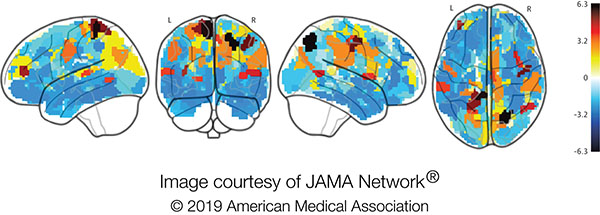Archived Content
The National Institute of Mental Health archives materials that are over 4 years old and no longer being updated. The content on this page is provided for historical reference purposes only and may not reflect current knowledge or information.
NIH Study Reveals Differences in Brain Activity in Children with Anhedonia
Using fMRI, researchers uncover the neural underpinnings, which could aid development of potential treatments
• Press Release
Researchers have identified changes in brain connectivity and brain activity during rest and reward anticipation in children with anhedonia, a condition where people lose interest and pleasure in activities they used to enjoy. The study, by scientists at the National Institute of Mental Health (NIMH), part of the National Institutes of Health, sheds light on brain function associated with anhedonia and helps differentiate anhedonia from other related aspects of psychopathology. The findings appear in the journal JAMA Psychiatry.
“Understanding the neural mechanisms of anhedonia that are distinguishable from other psychiatric concerns is important for clinicians to develop on-target treatments,” said lead study author Narun Pornpattananangkul, Ph.D., a postdoctoral fellow in the Emotion and Development Branch, part of NIMH’s Division of Intramural Research Programs. “Yet, disentangling shared characteristics from unique neural mechanisms of anhedonia is challenging because it often co-occurs with other psychiatric conditions.”
To learn more about the neurological underpinnings of anhedonia in children, researchers from the NIMH Division of Intramural Research Programs examined fMRI data collected from more than 2,800 children (9-10 years old) as part of the Adolescent Brain Cognitive Development (ABCD) Study . Some of the children included in the sample were identified as having anhedonia, low mood, anxiety, or attention-deficit/hyperactivity disorder (ADHD). fMRI data were collected while the children were at rest and while they completed tasks assessing reward anticipation and working memory.
Analysis of brain connectivity at rest revealed significant differences in children with anhedonia compared to children without anhedonia. Many of these differences were related to the connectivity between the arousal-related cingulo-opercular network and the reward-related ventral striatum area. These findings suggest that children with anhedonia have altered integration of reward and arousal compared to children without anhedonia.
When the researchers examined brain activity during the tasks, they found that children with anhedonia showed hypoactivation of brain regions involved in integrating reward and arousal during the reward anticipation task — but not the working memory task. This hypoactivation was not seen in children with low mood, anxiety, or ADHD. In fact, children with ADHD showed the opposite pattern: abnormalities in brain activation during the working memory task — but the not the reward anticipation task.
The study suggests that children with anhedonia have differences in the way their brain integrates reward and arousal and in the way their brain activates when anticipating rewards.
“We found anhedonia-specific alterations, such that youth with anhedonia, but not youth with low mood, anxiety, or ADHD, showed differences in the way they integrated reward and arousal and also showed diminished activity in reward-anticipation contexts,” said Dr. Pornpattananangkul. “This finding may start to provide the specific neural targets for treating anhedonia in youth.”

Image showing differences in fMRI activation between children with and without anhedonia during reward anticipation. Credit: JAMA Network
Reference
Pornpattananangkul, N., Leibenluft, E., Pine, D., & Stringaris, A. (in press). Mapping anhedonia in youth: Large-scale resting-state network, task-evoked activation and phenotypic demarcation. JAMA Psychiatry.
IRP Grant
About the National Institute of Mental Health (NIMH): The mission of the NIMH is to transform the understanding and treatment of mental illnesses through basic and clinical research, paving the way for prevention, recovery and cure. For more information, visit the NIMH website.
About the National Institutes of Health (NIH): NIH, the nation's medical research agency, includes 27 Institutes and Centers and is a component of the U.S. Department of Health and Human Services. NIH is the primary federal agency conducting and supporting basic, clinical, and translational medical research, and is investigating the causes, treatments, and cures for both common and rare diseases. For more information about NIH and its programs, visit the NIH website .
NIH…Turning Discovery Into Health®
